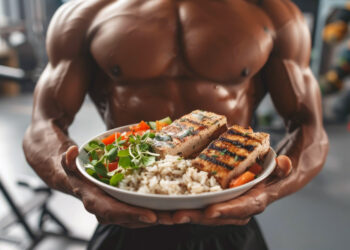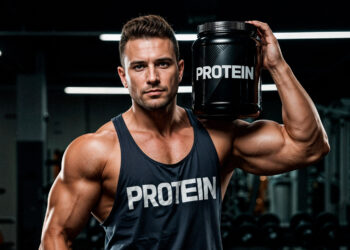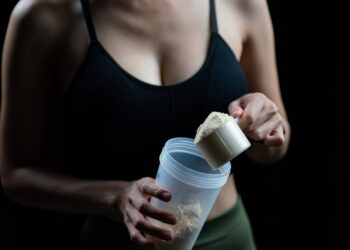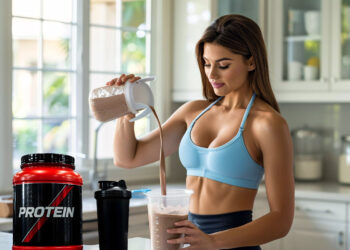There are many plant and animal protein options available, but some are better sources of protein than others. Both pea protein and whey protein are excellent sources of protein. But which is the better choice? Read on for a detailed comparison of pea protein versus whey protein.
Protein Dietary Needs
Protein is an essential macronutrient that supports muscle growth, repair, and function. The National Academy of Medicine recommends that adults consume 0.8 grams of protein per kilogram of body weight every day to meet dietary needs [1]. However, those engaging in strenuous exercise and who have goals to build and maintain muscle mass are advised to consume 1.4 – 2.0 grams of protein per kilogram of body weight every day, according to the International Society of Sports Nutrition [1].
Those who engage in strenuous exercise, such as athletes or bodybuilders, often consume protein powders to meet their daily protein needs [3]. You can calculate your daily protein needs easily with a protein calculator.
What is Whey Protein?
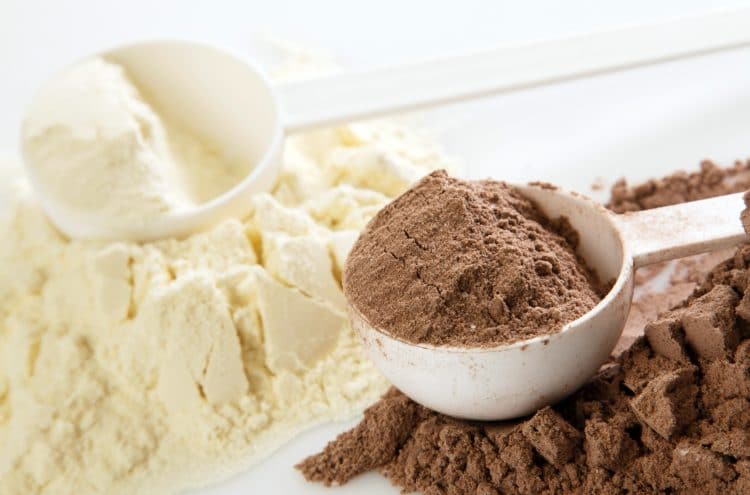
Whey protein is considered to be one of the most popular types of protein powders.
Whey protein is a protein found in cow’s milk. Cows milk contains 80% casein protein and 20% whey protein [1]. Whey protein is extracted from milk during the process of making cheese [3]. First, the milk is coagulated, meaning the milk solids (used for cheese) are separated from the liquid whey [5]. Then, the whey is pasteurized, filtered, evaporated, crystalized, and dried before packaging as a dietary supplement powder [5].
There are three types of whey protein [5]:
Level Up Your Fitness: Join our 💪 strong community in Fitness Volt Newsletter. Get daily inspiration, expert-backed workouts, nutrition tips, the latest in strength sports, and the support you need to reach your goals. Subscribe for free!
- Whey protein concentrate – Undergoes processes that make the final product low in fats and carbohydrates. It yields a protein concentration of 30-90%.
- Whey protein isolate – Undergoes further processing, and all fat and lactose are removed. It yields a protein concentration of 90%.
- Whey protein hydrolysate – Undergoes a partial hydrolysis process that breaks down the amino acids into peptides. Peptides are absorbed faster by the human body.
Whey protein concentrate and isolate are the most commonly found forms of whey protein as a protein powder.
What is Pea Protein?
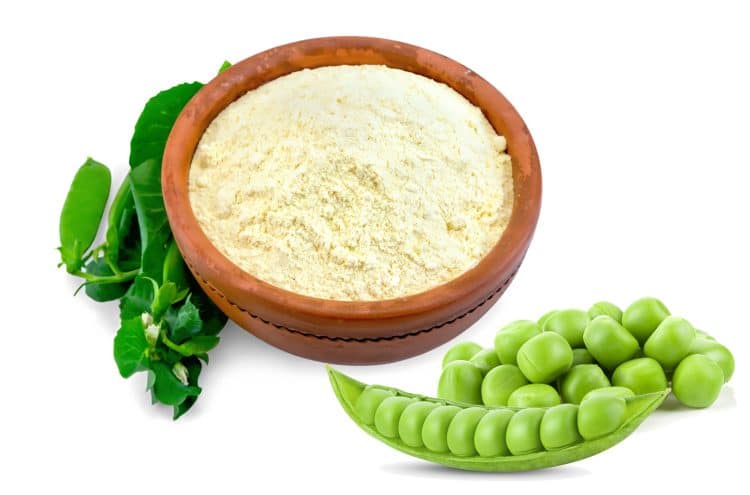
Pea protein is becoming more popular as a plant protein as plant-based diet trends continue to rise.
Pea protein powder is made from yellow split peas [1].
There are two forms of pea protein powders [1, 9]:
- Pea protein concentrate – the protein is extracted from the peas by drying and grinding the peas into a fine powder. Pea protein concentrate contains less protein than protein isolate and contains additional fats, carbohydrates, starch, and fiber.
- Pea protein isolate – is prepared by a wet processing method, where the fine pea powder is mixed with water to separate the fiber and starch, which is removed. Pea protein isolate contains 90% protein and each of the nine essential amino acids.
Pea Vs. Whey Protein – Nutrition Label Comparison
While different supplement brand protein powders have varying nutrition profiles, these two protein powders are comparable in form and ingredients.
| Optimum Nutrition Isolate Whey Protein Powder Drink Mix, Vanilla [11] | Nubeleaf Organic Pea Protein Whole Food Powder [12] | |
| Serving | 32 g | 20 g |
| Energy | 120 kcal | 80 kcal |
| Protein | 25 g | 16 g |
| Total lipid | 0 g | 1 g |
| Carbohydrate | 3 g | 1 g |
| Total Sugars | 0.998 g | 0 g |
| Added Sugars | 0.992 g | 0 g |
| Calcium | 120 mg | 0 g |
| Potassium | 130 mg | 0 mg |
| Sodium | 70.1 mg | 206 mg |
| Cholesterol | 5.12 mg | 0 g |
| Iron | 0 mg | 5.4 mg |
| Fiber, dietary | 0 g | 0.8 g |
Pea protein and whey protein are comparable in nutrition, at least in these product comparisons. Some protein powders may vary in ingredients and contain more nutrients, sugars, or fats.
Both pea protein and whey protein are rich in protein. Generally, whey protein contains more protein per serving than pea protein. However, the exact protein content amount varies between brands.
Both are also generally low in carbohydrates, fats, and sugars. Some brands do include extra ingredients that increase carbohydrates, fats, and sugars. So it is important to pay attention to the nutrition labels on the packaging when picking a protein powder.
Whey protein contains calcium and potassium since it is made from milk. Pea protein contains iron and a trace amount of fiber since.
Pea protein is significantly higher in sodium. If you need to limit the amount of sodium that you consume, whey protein would be more beneficial.
Pea Vs. Whey Protein – Amino Acids
Both pea protein and whey protein contain all nine essential amino acids. Amino acids are the building blocks of protein. They are essential because the body cannot produce them on its own, and they must be consumed through food. Amino Acids are used by the body for muscle growth and repair, maintaining skin cell production, organ function, and hormone release [13].
Amino Acid Comparison Chart
Grams of each amino acid per 100 grams of protein [13].
| Pea Protein | Whey Protein | |
| Histidine | 1.9 | 1.5 |
| Isoleucine | 3.7 | 4.9 |
| Leucine | 6.4 | 8.6 |
| Lysine | 5.7 | 7.2 |
| Methionine | 0.8 | 1.6 |
| Phenylalanine | 4.2 | 2.6 |
| Threonine | 2.8 | 5.7 |
| Tryptophan | 0.7 | 1.5 |
| Valine | 4.0 | 4.6 |
Pea protein and whey protein are both considered complete proteins because they contain all of the essential amino acids [1,3].
The clear differences are that pea protein is considerably low in methionine and tryptophan, which are greater in animal proteins [1]. Whey is notably higher in leucine, which is an important amino acid for muscle building [3].
Pea Vs. Whey Protein – Protein Quality and Digestion
Protein quality and digestibility depend on the protein’s ability to meet the body’s amino acid requirements [14]. The Protein Digestibility Corrected Amino Acid Score (PDCAAS) is a score given to proteins that indicate the quality and digestibility of protein sources [14]. If the PDCAAS given to a protein is less than 100%, that protein cannot fully meet the body’s amino acid requirements [14].
Protein Digestibility Corrected Amino Acid Scores:
Yellow split peas – 64
- Pea protein concentrate – 89
- Soy protein isolate – 100
- Soy flour – 93
- Black beans (cooked) – 65
- Whey protein – 100
- Casein – 100
- Milk – 100
- Egg – 100
- Red meat – 92
All plant-based proteins have a PDCAAS score below 100%, except soy protein isolate. This means that animal proteins have higher quality protein than plant proteins. The lower score given to plant proteins may be because they have a lower digestibility than animal proteins or because they are deficient in certain essential amino acids [14]. Plant proteins may not be as digestible as animal proteins because of the difference in protein structure [14].
Whey protein is digested much more quickly than any plant protein, meaning that the amino acids are absorbed more rapidly by the body [3].
Pea Vs. Whey Protein – Texture and Taste
Pea protein blends well. It has a smooth and creamy texture, but tends to be grainier than whey protein. Blending pea protein with a creamy base, such as cow milk or plant milk, can help smooth out the texture. However, this would add calories to your protein drink.
Generally, pea protein can taste earthy, bitter, and chalky if it is unflavored. But there are flavored pea protein powders available that can help mask the natural taste.
Whey protein blends very well, even in water. Since it is a product derived from milk, it has a light milky taste and texture. Unflavored whey protein mixed with water will taste similar to watered-down milk.
There are an immense number of flavors of whey protein powder available on the market. There is a flavor for any taste preference.
Pea Vs. Whey Protein – Allergens and Intolerances
Pea protein is naturally free of the most common food allergens such as peanuts, tree nuts, eggs, cow’s milk, wheat, soy, and fish. Since pea protein is gluten-free, dairy-free, and vegan, it can be consumed in almost any diet.
However, some allergic reactions to pea protein have occurred in children who had previous reactions to nuts or legumes. If you have had any prior allergic reactions to tree nuts, peanuts, or legumes, pea protein should be consumed with caution [2].
Since whey protein is made from cow’s milk, anybody with a milk allergy should not consume whey protein [3].
Level Up Your Fitness: Join our 💪 strong community in Fitness Volt Newsletter. Get daily inspiration, expert-backed workouts, nutrition tips, the latest in strength sports, and the support you need to reach your goals. Subscribe for free!
People who are lactose intolerant could consume whey isolate because almost all of the lactose is removed during processing, and they may not be affected [6].
Whey protein powders may also contain gluten, depending on the manufacturer.
People also need to be cautious when consuming whey protein with some medications, as they may interact negatively [4]. Specifically, whey protein is known to decrease the effectiveness of medications such as levodopa, bisphosphonates, and some variations of antibiotics [4].
Pea Vs. Whey Protein – Muscle Gain
Protein is an essential nutrient for muscle growth and repair. When you engage in physical activity, such as resistance training or weightlifting, muscle fibers are challenged, and this causes structural damage to muscles. The body utilizes the essential amino acids from protein to repair the damaged muscle fibers and forms new muscle protein strands, which increases muscle gain [1].
Studies show that pea protein and whey protein have similar effects on muscle gain. This is because both pea protein and whey protein contain all of the essential amino acids. However, whey protein is higher in leucine which is rapidly digested and may stimulate muscle growth faster than pea protein.
One study found that men who consumed 50 grams of pea protein every day and engaged in resistance training over 12 weeks had similar muscle thickness gains as those who consumed 50 grams of whey protein and engaged in the same exercise regimen [1]. Other studies have confirmed that pea protein promotes muscle thickness just as well as whey protein [7, 8].
Another study found that pea protein and whey protein promoted similar muscular adaptions, strength performance, and body composition [8].
Regarding muscle strength, some research shows that pea protein may be more beneficial in increasing muscle strength in adults who regularly engage in high-intensity training [2]. However, they also found that pea protein was not more effective than whey protein in increasing muscle strength in men who engaged in regular resistance training [2].
Overall, consuming whey protein or pea protein produces similar muscle gains and muscle thickness [14]. But, protein must be consumed consistently along with a regular exercise regimen to see benefits [4].
Related: TDEE Calculator: Calculate Total Daily Energy Expenditure
Pea Vs. Whey Protein – Weight Loss
Protein plays a key role in weight regulation. When combined with regular exercise, protein can aid in your body favoring fat-free mass over fat mass and increase satiety [17]. Satiety, the feeling of being satisfied after eating, can reduce caloric intake throughout the day and lead to weight loss over time [15].
Some research shows that pea protein has a stronger effect on increasing satiety due to its fiber content [16].
Another studied showed that individuals who had a caloric deficit of 500 calories a day, consumed whey protein, and engaged in regular daily exercise lost body fat and maintained lean muscle mass [18].
Overall, research shows that consuming any protein supplements 30 minutes before a meal may help you lose body fat and maintain muscle mass when accompanied by a caloric defect and regular exercise [16, 18].
Pea Vs. Whey Protein – Other Considerations
Pea protein is perfect for those who have food intolerances, allergies, or preferences because it is gluten-free, lactose-free, and vegan. Aside from pea protein being favored by vegans because it is a plant protein, it is also a more sustainable product.
Pea protein is also rich in iron, which is beneficial if you do not eat animal products.
It is also important to consider that even though pea protein is becoming more popular, it is harder to find and is more expensive than whey protein.
Protein powders can vary in ingredients and nutrition depending on the brand. Even if you prefer pea or whey protein over the other, always look at the nutrition labels and purchase protein powder supplements that are high quality and only have a limited amount of added ingredients.
The FDA does not review workout supplements [1]. So we are not guaranteed that protein powders are safe or effective. It is up to you to do your own research and make sure that the protein powder products you purchase contain ingredients that you feel comfortable and confident consuming.
FAQs
What is healthier: whey protein or pea protein?
Both whey protein and pea protein are considered healthy sources of protein in their natural form. However, you should be cautious when purchasing protein powders because they are not regulated by the FDA. They can contain many additive ingredients that are unhealthy or cause harm.
Can you build muscle with pea protein?
It is possible to build muscle with pea protein since it contains all of the essential amino acids which are necessary for muscle repair and growth.
Can I mix pea protein with whey protein?
Yes, you can mix pea protein with whey protein. There are no negative interactions when combining them. Research also shows that combining plant proteins with animal proteins can increase the nutritional quality of the protein, such as mixing pea protein with whey [14].
Can I consume too much protein?
Yes, it is possible to consume too much protein, and it may cause some health problems if you overconsume long term. It is recommended that people do not consume more than 2.0 grams of protein per kilogram of bodyweight. Consuming too much protein can cause intestinal discomfort, dehydration, nausea, headaches, and diarrhea.
Wrapping Up – Which is Better, Pea or Whey Protein?
It is difficult to decide on a winner between pea protein and whey protein.
Both pea and whey protein are comparable in nutritional values. They are equally rich in protein and naturally low in carbohydrates, fats, and sugars. The only notable consideration is that pea protein is much higher in sodium.
Pea protein and whey protein are also considered complete proteins since they both contain all nine essential amino acids that the body requires for function. However, whey protein is considerably higher in leucine, which is necessary for muscle building.
Research shows that whey protein is digested much faster than plant proteins, meaning that the amino acids in whey protein are absorbed by the body’s muscles faster than in pea protein.
Whey protein powder is a clear winner for taste and texture. It blends smooth in water and does not taste chalky or earthy. Whey protein powder is also available in many more flavors than pea protein. Whatever your flavor preferences are, you can most likely find it as a whey protein powder flavor.
Pea protein wins over whey protein in the arena of allergens and intolerances. Pea protein is free of all of the common food allergens. Whey should not be consumed by anyone with a cow’s milk allergy or lactose intolerance.
Lastly, pea protein and whey protein are equally effective for muscle gain and weight loss. Research shows that both proteins can increase muscle gain and strength. Whey protein, however, may have a slight advantage because it is higher in leucine. Both proteins can also aid in weight loss when consumed in a caloric deficit diet and along with engaging in a regular exercise routine.
Overall, whey protein is a clear winner in protein quality, digestibility, and taste. The only area where pea protein is a clear winner is that it contains no allergens. The winner to you will ultimately depend on your preferences.
References
- Harvard: School of Public Health. (2021, December 17). Workout Supplements. The Nutrition Source. https://www.hsph.harvard.edu/nutritionsource/workout-supplements/
- (2020). PEA PROTEIN: Overview, Uses, Side Effects, Precautions, Interactions, Dosing and Reviews. https://www.webmd.com/vitamins/ai/ingredientmono-1561/pea-protein
- Operation Supplement Safety. (2019, February 26). Whey protein: The basics. Opss. https://www.opss.org/article/whey-protein-basics
- (2021, August 26). Whey Protein: MedlinePlus Supplements. https://medlineplus.gov/druginfo/natural/833.html
- Colorado Integrated Food Safety Center. (2022, March 10). Protein Powder | Food Source Information. ColoradoState Edu. https://fsi.colostate.edu/protein-powder/
- (2021, April 23). Difference Between Whey and Whey Isolate. https://www.webmd.com/diet/difference-whey-and-whey-isolate
- Babault, N., Païzis, C., Deley, G., Guérin-Deremaux, L., Saniez, M. H., Lefranc-Millot, C., & Allaert, F. A. (2015). Pea proteins oral supplementation promotes muscle thickness gains during resistance training: a double-blind, randomized, Placebo-controlled clinical trial vs. Whey protein. Journal of the International Society of Sports Nutrition, 12(1). https://doi.org/10.1186/s12970-014-0064-5
- Banaszek, A., Townsend, J. R., Bender, D., Vantrease, W. C., Marshall, A. C., & Johnson, K. D. (2019). The Effects of Whey vs. Pea Protein on Physical Adaptations Following 8-Weeks of High-Intensity Functional Training (HIFT): A Pilot Study. Sports, 7(1), 12. https://doi.org/10.3390/sports701001
- Colmenero, F. J. (2014). CHEMISTRY AND PHYSICS OF COMMINUTED PRODUCTS | Nonmeat Proteins. Encyclopedia of Meat Sciences, 289–295. https://doi.org/10.1016/b978-0-12-384731-7.00140-9
- Sandberg, A. S. (2011). Developing functional ingredients: a case study of pea protein. Functional Foods, 358–382. https://doi.org/10.1533/9780857092557.3.358
- (2021, July 29). Isolate Whey Protein Powder Drink Mix Vanilla. FoodData Central. https://fdc.nal.usda.gov/fdc-app.html#/food-details/1960410/nutrients
- (2021, October, 28). Organic Pea Protein Whole Food Powder. FoodData Central. https://fdc.nal.usda.gov/fdc-app.html#/food-details/2174683/nutrients
- Babault, N. (2015, January 21). Pea proteins oral supplementation promotes muscle thickness gains during resistance training: a double-blind, randomized, Placebo-controlled clinical trial vs. Whey protein – Journal of the International Society of Sports Nutrition. BioMed Central. https://jissn.biomedcentral.com/articles/10.1186/s12970-014-0064-5/tables/3
- Berrazaga, I., Micard, V., Gueugneau, M., & Walrand, S. (2019). The Role of the Anabolic Properties of Plant- versus Animal-Based Protein Sources in Supporting Muscle Mass Maintenance: A Critical Review. Nutrients, 11(8), 1825. https://doi.org/10.3390/nu11081825
- Weigle, D. S., Breen, P. A., Matthys, C. C., Callahan, H. S., Meeuws, K. E., Burden, V. R., & Purnell, J. Q. (2005). A high-protein diet induces sustained reductions in appetite, ad libitum caloric intake, and body weight despite compensatory changes in diurnal plasma leptin and ghrelin concentrations. The American Journal of Clinical Nutrition, 82(1), 41–48. https://doi.org/10.1093/ajcn/82.1.41
- Abou-Samra, R., Keersmaekers, L., Brienza, D., Mukherjee, R., & Macé, K. (2011). Effect of different protein sources on satiation and short-term satiety when consumed as a starter. Nutrition Journal, 10(1). https://doi.org/10.1186/1475-2891-10-139
- Paddon-Jones, D., Westman, E., Mattes, R. D., Wolfe, R. R., Astrup, A., & Westerterp-Plantenga, M. (2008). Protein, weight management, and satiety. The American Journal of Clinical Nutrition, 87(5), 1558S-1561S. https://doi.org/10.1093/ajcn/87.5.1558s
- Frestedt, J. L., Zenk, J. L., Kuskowski, M. A., Ward, L. S., & Bastian, E. D. (2008). A whey-protein supplement increases fat loss and spares lean muscle in obese subjects: a randomized human clinical study. Nutrition & Metabolism, 5(1). https://doi.org/10.1186/1743-7075-5-8





